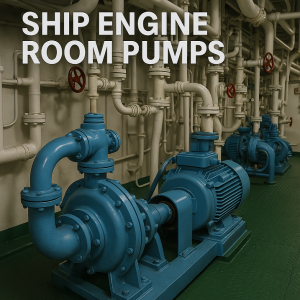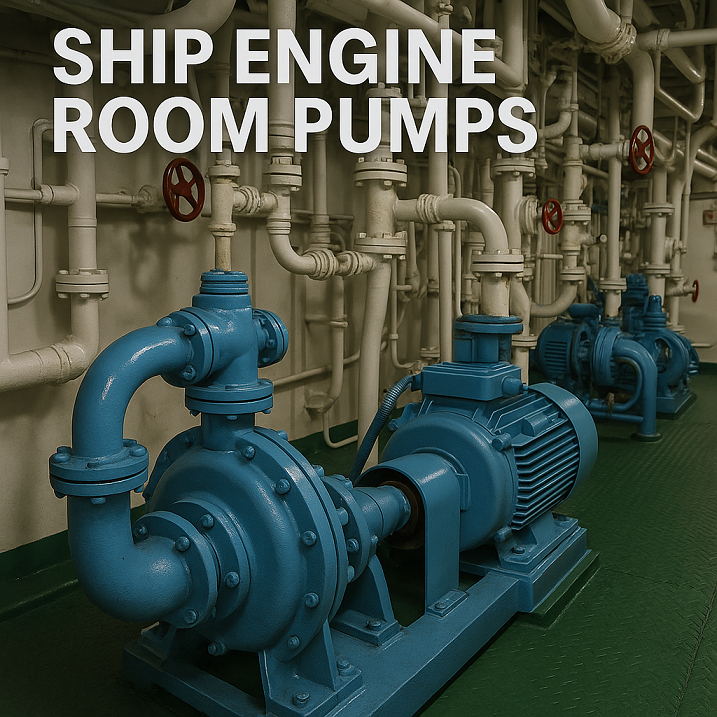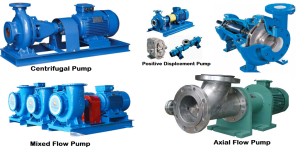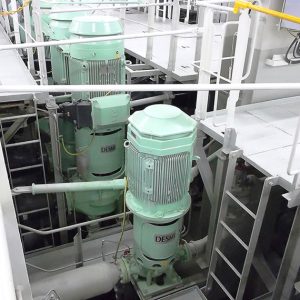Discover the essential types of pumps used in ship engine rooms. Learn about centrifugal, positive displacement, and specialized pumps with real-world examples, latest trends, and practical tips.
Why Understanding Pumps is Critical for Maritime Operations
Did you know that without properly functioning pumps, a ship could lose propulsion, face engine failure, or even flood?
In a ship’s engine room, pumps are vital for moving essential fluids like water, oil, and fuel. They regulate temperature, maintain lubrication, transfer fuel, and manage ballast and bilge water levels — all crucial to a vessel’s performance and safety.
In this guide, we’ll dive deep into the types of ship engine room pumps, their functions, modern applications, and why they matter more than ever in today’s maritime world.
Why Pumps Are Vital in Ship Engine Rooms
The engine room operates like a ship’s heart, requiring continuous circulation of fluids to cool, lubricate, and power its systems. Pumps ensure:
-
Cooling of engines and generators.
-
Fuel transfer and injection at precise pressures.
-
Lubrication to prevent mechanical failures.
-
Bilge and ballast control for stability and safety.
Without reliable pumps, core ship functions could grind to a halt, leading to costly downtime, safety risks, or even environmental hazards.

Main Types of Pumps Used in Ship Engine Rooms
Ship pumps are generally classified into two main categories:
-
Rotodynamic Pumps
-
Positive Displacement Pumps
Each type has unique characteristics suited for specific marine applications.

1. Rotodynamic Pumps
Rotodynamic pumps create flow through the dynamic action of rotating impellers. They are ideal for high-flow, low-viscosity fluids like seawater.
Centrifugal Pumps
Working Principle:
Use centrifugal force generated by a rotating impeller to move fluid.
Advantages:
-
High flow rate
-
Simple, efficient design
-
Low maintenance
Applications:
-
Cooling Water Systems: Circulates seawater or freshwater to cool engines.
-
Ballast Systems: Adjusts ship stability.
-
Firefighting Systems: Delivers large volumes of water during emergencies.
-
Bilge Systems: Removes water accumulated in the bilge.
Axial Flow Pumps
Working Principle:
Moves fluid parallel to the shaft, creating a consistent, high-volume flow.
Applications:
-
Large-volume water circulation
-
Flooding or de-ballasting operations
Mixed Flow Pumps
Working Principle:
Combines radial and axial flow features for versatile performance.
Applications:
-
Ballast water transfer
-
General water pumping tasks
Turbine Pumps
Working Principle:
Delivers high-pressure fluid flow via a multi-stage impeller setup.
Applications:
-
Boiler feedwater
-
Specialized high-pressure systems
2. Positive Displacement Pumps
Positive displacement pumps move a fixed amount of fluid per cycle, making them perfect for high-viscosity fluids like fuel oil or lubricating oil.
They are divided into:
-
Rotary Pumps
-
Reciprocating Pumps
a) Rotary Pumps
Gear Pumps
Working Principle:
Meshing gears trap and move fluid efficiently.
Applications:
-
Fuel transfer (HFO, MGO)
-
Lubrication of engine parts
Lobe Pumps
Working Principle:
Rotating lobes transfer fluids gently with minimal shear.
Applications:
-
Viscous or delicate fluid transfer (e.g., lubrication oil)
Sliding Vane Pumps
Working Principle:
Vanes slide in and out of a rotor to maintain consistent fluid movement.
Applications:
-
Handling fluids of varying viscosities (e.g., fuel oils)
Screw Pumps
Working Principle:
Rotating screws push fluid steadily along the pump axis.
Advantages:
-
Smooth, non-pulsating flow
-
Quiet operation
-
Excellent for viscous fluids
Applications:
-
Heavy fuel oil transfer
-
Lubrication circulation
-
Booster pumps for fuel injection
b) Reciprocating Pumps
Piston Pumps
Working Principle:
A piston moves back and forth inside a cylinder, generating fluid pressure.
Applications:
-
Hydraulic winches and steering gears
-
High-pressure fuel injection systems
Diaphragm Pumps
Working Principle:
A flexible diaphragm displaces fluid, minimizing contact with moving parts.
Applications:
-
Abrasive or corrosive fluid handling (e.g., bilge water)
Plunger Pumps
Working Principle:
Similar to piston pumps but with a smaller, more powerful plunger for very high-pressure needs.
Applications:
-
Hydraulic power systems
-
High-pressure cleaning systems
Application-Specific Pump Examples
Here’s how different types of pumps are matched to shipboard operations:
| Application | Pump Type | Key Function |
|---|---|---|
| Bilge Water Removal | Centrifugal or Positive Displacement | Stability and emergency management |
| Firefighting Systems | Centrifugal Pumps | Rapid water delivery |
| Ballast Systems | Centrifugal Pumps | Trim and stability adjustment |
| Cooling Systems | Centrifugal Pumps | Engine temperature regulation |
| Boiler Feed | Positive Displacement Pumps | Maintain boiler water levels |
| Fuel Oil Transfer | Rotary (Gear/Screw) Pumps | Steady fuel delivery |
| Hydraulic Systems | Reciprocating Pumps | Precision control |
Centrifugal vs Positive Displacement Pumps: Key Differences
| Feature | Centrifugal Pump | Positive Displacement Pump |
|---|---|---|
| Flow Nature | Continuous, variable with system resistance | Fixed, steady regardless of system pressure |
| Fluid Type | Low-viscosity (seawater) | High-viscosity (fuel oils) |
| Pressure Handling | Varies | High pressure, consistent |
| Typical Applications | Cooling, ballast, firefighting | Fuel transfer, lubrication, hydraulics |
Quick Tip:
Choose centrifugal for large volumes of water at low to medium pressure, and positive displacement for precise control or viscous fluids.
Recent Trends in Marine Pump Technology (2024 Update)
-
Smart Pumps: IoT integration for real-time monitoring and predictive maintenance.
-
Energy-Efficient Designs: New impeller shapes and optimized drive systems.
-
Corrosion-Resistant Materials: Advanced composites and duplex stainless steels.
-
IMO Regulations Compliance: Pumps adapted for low-sulfur fuels and environmentally sensitive bilge systems.
FAQs: Understanding Ship Engine Room Pumps
Q1: What is the most common type of pump in ship engine rooms?
A: Centrifugal pumps dominate due to their high flow rates and suitability for seawater and cooling systems.
Q2: Why are positive displacement pumps critical for heavy fuel oil?
A: They can handle high-viscosity fluids under high pressures, maintaining a steady, reliable flow essential for engine performance.
Q3: Can a single pump type handle multiple fluids?
A: Some versatile designs like screw pumps can manage a range of fluid viscosities, but usually pumps are optimized for specific fluids and tasks.
Q4: How often should ship pumps be maintained?
A: Regular inspections are typically scheduled monthly, with full maintenance aligned with dry-docking cycles or major overhauls.
Final Thoughts: Pumps — The Unsung Heroes of the Engine Room
Without pumps, a ship would cease to operate safely or efficiently. Understanding the types of pumps, their specific functions, and their maintenance requirements is crucial for marine engineers, students, and maritime enthusiasts alike.
By mastering these systems, you help ensure safe voyages, efficient operations, and environmental compliance on the world’s oceans.
Further Reading and Resources
CTAs: 👉 Explore our full engine room operations guide here.
👉 Interested in marine engineering careers? Check out our courses.




hi